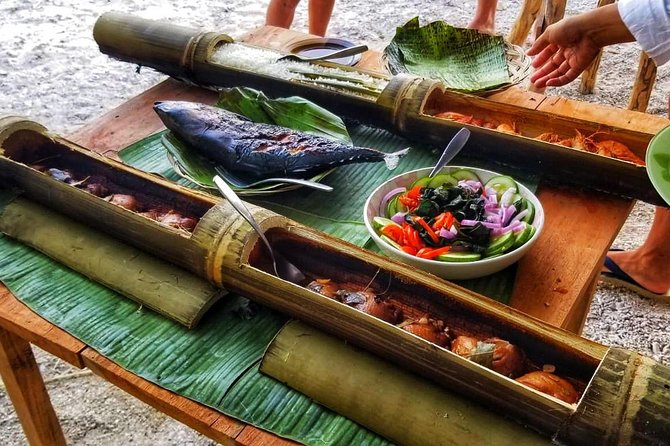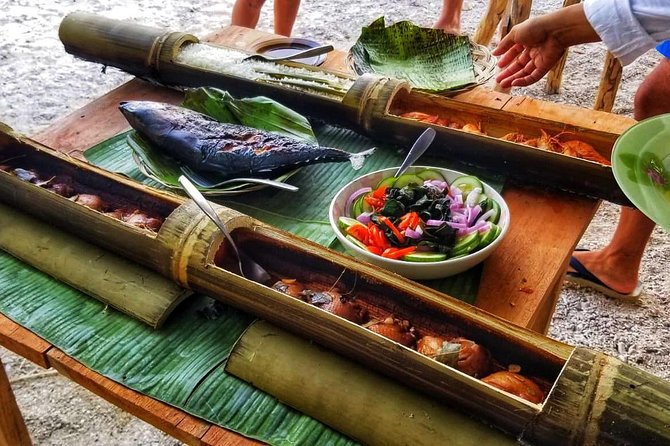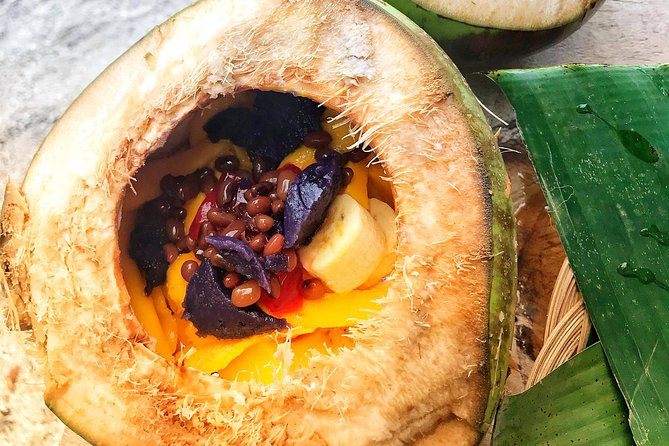Set out on a culinary adventure through the flavors of Traditional Filipino Bamboo Cooking, where dishes are elevated by the unique cooking vessel of bamboo.
Imagine succulent pork belly marinated in vinegar and soy sauce, slowly cooked in a bamboo tube over an open flame, infusing the meat with a smoky aroma.
As the bamboo imparts a distinct earthy flavor to each dish, one can’t help but wonder about the intricate techniques and cultural significance behind this age-old tradition.
Discover the secrets of bamboo cooking and unlock a world of flavors waiting to be explored.
Good To Know

- Bamboo cooking showcases Filipino culinary creativity and heritage.
- Essential ingredients like vinegar, garlic, and seafood form flavorful dishes.
- Techniques like steaming and grilling in bamboo enhance flavors.
- Bamboo cooking promotes sustainability and eco-friendly practices in Filipino cuisine.
History of Bamboo Cooking in the Philippines

Bamboo cooking has been an integral part of Filipino culinary tradition, dating back centuries and showcasing the creativity and resourcefulness of Filipino cooks. The evolution of techniques in bamboo cooking reflects the rich culinary heritage of the Philippines.
Over time, Filipino cooks have mastered the art of using bamboo as a cooking vessel, creating dishes like Chicken Adobo, Steamed Shrimp, and Tuna in Coconut Ginger Sauce. This method of cooking not only imparts a unique flavor to the food but also retains the natural juices and aromas, enhancing the overall dining experience.
The tradition of bamboo cooking has been passed down through generations, preserving a connection to the past while embracing innovation in Filipino cuisine.
Want to learn local cooking? Other Cebu cooking classes we've covered
Essential Ingredients for Traditional Filipino Dishes

Exploring the diverse culinary landscape of traditional Filipino dishes reveals a vibrant array of essential ingredients that form the foundation of these flavorful creations.
Filipino cooking thrives on the use of key elements such as vinegar, garlic, soy sauce, bay leaves, and peppercorns, which are commonly found in dishes like Chicken Adobo.
Coconut milk, ginger, vinegar, onion, and garlic are essential components in creating authentic flavors in dishes like Tuna in Coconut Ginger Sauce.
Fresh seafood like shrimp steamed inside bamboo cases showcases the traditional techniques and flavors of Filipino cuisine.
Rice, a staple in Filipino cooking, is often wrapped in coconut leaves and steamed to perfection, as seen in Hanging Rice.
These essential ingredients come together to create the rich tapestry of flavors that define traditional Filipino dishes.
Techniques for Cooking With Bamboo
In traditional Filipino cooking, bamboo serves as a versatile and innovative tool that enhances the flavors and textures of dishes through unique cooking techniques.
- Bamboo Cooking Methods:
- Bamboo Steaming: Bamboo steamers are commonly used to infuse dishes with a subtle, earthy flavor while retaining moisture and nutrients.
- Bamboo Grilling: Bamboo skewers or mats can be utilized for grilling meats, seafood, and vegetables, imparting a smoky essence to the food.
- Bamboo Boiling: Bamboo tubes filled with ingredients and hot water create a natural pressure cooker effect, ideal for soups and stews.
These sustainable cooking practices not only add an authentic touch to Filipino cuisine but also promote eco-friendly alternatives in the kitchen.
Benefits of Bamboo Cooking
Utilizing bamboo in cooking enhances flavors, introduces unique cooking techniques, and promotes sustainability within traditional Filipino cuisine. The advantages of bamboo cooking go beyond just the taste it imparts to the dishes.
Bamboo is a sustainable resource that grows abundantly in the Philippines, making it an eco-friendly choice for cooking vessels. Health benefits also come into play as bamboo contains natural antioxidants that can infuse into the food during the cooking process. Plus, cooking with bamboo offers a one-of-a-kind culinary experience, where the natural fibers of the bamboo infuse subtle earthy tones into the food, providing a distinct flavor profile.
Embracing bamboo cooking not only elevates the taste of the dishes but also contributes to a more environmentally conscious and healthier way of cooking.
Popular Bamboo Cooking Recipes
Indulge in the delectable flavors of traditional Filipino cuisine with these popular bamboo cooking recipes that showcase the rich culinary heritage of the Philippines.
Chicken Adobo: A classic Filipino dish, this savory stew features chicken or pork cooked in a flavorful blend of vinegar, garlic, soy sauce, bay leaves, and peppercorns, creating a perfect balance of tangy and salty flavors.
Steamed Shrimp: Fresh shrimp steamed inside a bamboo case, preserving the natural sweetness of the seafood while infusing it with aromatic bamboo notes, a true delight for seafood lovers.
Tuna in Coconut Ginger Sauce: Tuna cooked in a luscious sauce made with vinegar, pepper corn, onion, garlic, and coconut milk, offering a rich and creamy dish that highlights the diverse flavor profiles of Filipino culinary traditions.
- Cebu: Bantayan Island and Virgin Island Hopping Day Tour
- From Cebu City: Cebu Safari and Adventure Park Day Tour
- Mactan International Airport to Cebu City Hotel
- Traditional Filipino Bamboo Cooking Class
- From Cebu: Whale Shark Tour and Tumalog Falls Private Tour
- Bohol Countryside Private Tour From Cebu City
Serving and Presentation of Bamboo Cooked Dishes
For an authentic and visually appealing dining experience, showcasing the artistry of Filipino cuisine, the serving and presentation of bamboo cooked dishes play a crucial role in enhancing the overall meal. Bamboo plating is a traditional method that adds a rustic charm to the table setting, elevating the aesthetic serving of dishes.
Culinary art is demonstrated through the careful arrangement of bamboo-cooked delicacies, creating a feast for both the eyes and the palate. The natural hues and textures of bamboo complement the vibrant colors of Filipino dishes, enhancing their visual appeal.
When served in bamboo containers or on bamboo plates, these dishes not only pay homage to Filipino heritage but also bring a unique touch to the dining experience, making it memorable and visually stunning.
Cultural Significance of Bamboo Cooking
The artful presentation of bamboo-cooked dishes not only enhances the dining experience aesthetically but also holds deep cultural significance in Filipino culinary traditions.
Cultural Significance of Bamboo Cooking:
Bamboo utensils: Bamboo has been used for centuries in Filipino cooking, imparting a unique flavor to dishes and showcasing the resourcefulness of the Filipino people in utilizing natural materials.
Culinary heritage: Cooking in bamboo reflects the rich culinary heritage of the Philippines, passed down through generations, showcasing traditional methods and flavors that have stood the test of time.
Sustainability: Bamboo cooking aligns with the principles of sustainability, promoting eco-friendly practices that respect nature and minimize environmental impact, a value deeply embedded in Filipino culture.
Common Questions
Can Bamboo Be Reused for Cooking Multiple Dishes, or Is It Typically Used Only Once?
Bamboo sustainability in cooking involves reusing bamboo for multiple dishes. This practice not only showcases flavor infusion but also promotes eco-friendly cooking methods. Reusing bamboo can enhance the overall taste experience while minimizing waste and supporting sustainability efforts.
Are There Specific Types of Bamboo That Are Best Suited for Cooking Traditional Filipino Dishes?
When selecting bamboo for cooking, consider its freshness, thickness, and lack of cracks. Utilize techniques like steaming, grilling, or using as a container. Bamboo enhances flavors through infusion and unlocks diverse culinary possibilities, making it a versatile and eco-friendly cooking tool.
How Long Does It Take to Cook a Dish Using Bamboo as a Cooking Vessel Compared to Traditional Methods?
When comparing cooking time efficiency between bamboo and traditional methods, bamboo can infuse flavors faster due to its porous nature. It also offers sustainability and versatility in cooking, making it a unique and eco-friendly option for culinary endeavors.
Are There Any Special Preparations Needed for Bamboo Before Using It for Cooking?
Before using bamboo for cooking, it requires a thorough cleaning process to remove impurities. This step ensures food safety and prevents contamination. Cooking techniques involve proper seasoning and sealing to enhance flavor infusion. Bamboo cooking offers unique health benefits.
Can Bamboo Cooking Be Adapted for Vegetarian or Vegan Filipino Dishes?
Adapting recipes to suit vegetarian or vegan preferences involves creativity and understanding flavor profiles. Sustainability in cooking is achievable by sourcing locally and using plant-based alternatives. Bamboo cooking can be adapted by using ingredients like tofu, mushrooms, and seasonal vegetables.
The Sum Up
To sum it up, Traditional Filipino Bamboo Cooking offers a unique and flavorful culinary experience that captures the essence of Filipino culture and tradition.
With a rich history, essential ingredients, and techniques that enhance the flavors of each dish, bamboo cooking showcases the creativity and ingenuity of Filipino cuisine.
Whether enjoying a classic Chicken Adobo or a modern twist on a dessert, this age-old cooking method is sure to delight your taste buds and leave you craving for more.
Experience the magic of bamboo cooking and savor the authentic flavors of the Philippines.
More Cooking Classes in Cebu
More Tour Reviews in Cebu
Looking for something different? Other Cebu activities we've written about
- Best Workshops And Classes In Cebu
- 15 Best Snorkeling Experiences In Cebu
- 3 Best 3 Day Tours In Cebu
- 20 Best Whale Watching Experiences In Cebu
- 5 Best Scuba Diving Experiences In Cebu
- 8 Best Historical Tours In Cebu
- 3 Best 2 Day Tours In Cebu
- 8 Best Airport Transfers In Cebu
- 20 Best Private Driver Services In Cebu
- 5 Best Safari Tours In Cebu
- 11 Best Full-Day Tours In Cebu
- 11 Best Boat Tours And Cruises In Cebu
